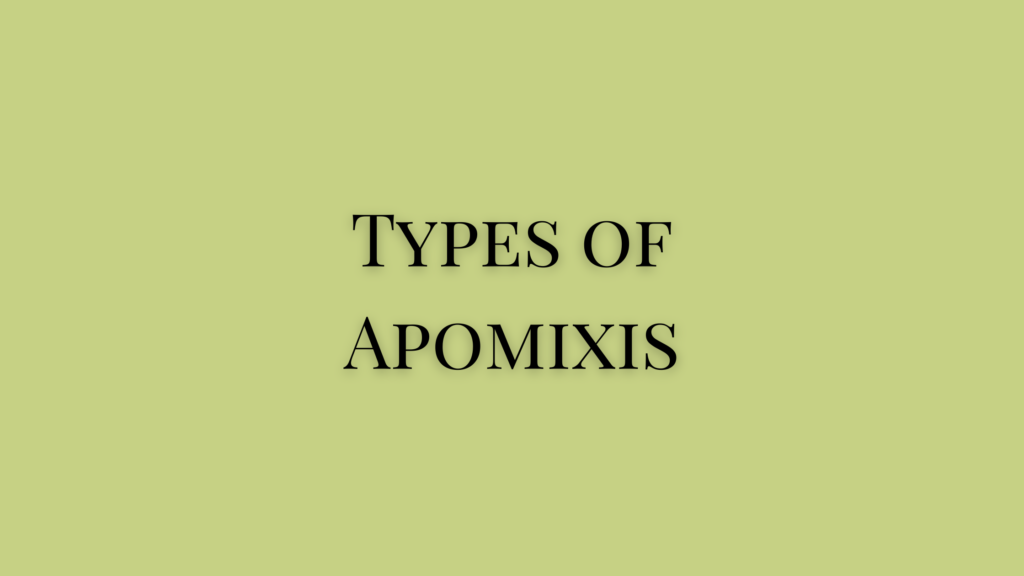Apomixis was discovered in citrus seeds by Leuwen Hock in 1719. The term Apomixis comes from two Greek words- APO and MIXIS which means “away from” and “act of mixing” respectively.
Here the seeds contain embryos that are developed without fertilization. Therefore, their genotypes are the same as the parent plant. There are two types of apomixis which we will discuss here.
Definition of Apomixis
Apomixis may be defined as the condition in which sexual reproduction (amphimixis) in a flower is replaced by some form of asexual reproduction that does not involve any nuclear fusion. It may happen from a haploid or diploid cell.
In some plants, diploid cells inside the ovule develop into embryos thus resulting in diploid plants. Such seedlings are called apomicts that are identical to the mother plants. As they mature, they may or may not be able to reproduce sexually.
When these apomicts are able to reproduce sexually, such apomixes are called facultative apomixis and if sexual reproduction is absent, it is called obligate apomixis.
Types of Apomixis
Recurrent Apomixis
Recurrent apomixis is the development of an embryo from the diploid archesporium or any other diploid somatic cells. Such apomixis is of two types- generative apospory and somatic apospory.
- Generative Apospory: In Eupatorium glandulosum, the megaspore mother cell undergoes mitosis irregularly. The cell elongates to destroy the nucellar epidermis leading to a triploid state. This nucleus divides thrice to form 8 nuclei in the embryo sac. AN embryo is developed from the diploid egg cell.
- Somatic Apospory: In some species of Hieracium, the megaspore mother cell undergoes normal meiotic division. At the same time, a somatic cell from the chalazal region enlarges and undergoes mitotic division to form a diploid embryo sac.
Recurrent apomixis may happen with or without a trigger from pollination. Some species of Poa, Taraxacum, Crepis, and Allium do not require the stimulus of pollination. On the other hand, for plants such as Malus, Parthenium, Rubus, etc., a pollination stimulus is necessary for embryo development or for a viable endosperm formation.
Non-Recurrent Apomixis
Non-recurrent apomixis is the process where the embryo is formed directly from the haploid egg or any other haploid cells from a gametophyte, without fertilization. The resultant embryos will be sterile due to a haploid set of chromosomes. Since these haploid embryos cannot be repeated in the next generation, such apomixis is called non-recurrent.
This was discovered in Solanum nigrum by C A Jorgensen. He observed that the pollen tube that entered the embryo sac failed to fuse with the egg. Instead of fertilization, the presence of the male gametophyte stimulated the haploid egg to form a haploid embryo.
If the embryo is formed from the haploid egg cell it is called haploid parthenogenesis and if the embryo is developed from other haploid cells, it is called haploid apogamy.
Nucellar Embryony or Adventitious Embryony
Nucellar embryony is common in sub-tropical and tropical trees such as mango and citrus. Adventitious embryony nucellar embryony nucellar budding or sporophyte budding is the process where the embryo is developed from a single cell of a group of cells from the nucellus or integuments.
These cells or cells arise from budding and project into the embryosac. These embryos will be diploid and usually develop outside the embryo sac. Moreover, they may be formed in addition to the normal embryos. This condition is called polyembryony.
In Opuntia, polyembryony is seen without the stimulus of pollination and shows the presence of both apomictic and zygotic embryos. Poincirus trifoliata or trifoliate orange seeds develop several seedlings from a single seed.
Among these, the weakest seedling shows sexual reproduction while the others are apomicts. These nucellar seedlings stay true to the mother plants, can be used as virus-free rootstocks, and are more vigorous than zygotic seedlings.
Vegetative Apomixis or Bulbils
In this type, instead of normal flowers, the inflorescence produces bulbils or vegetative buds. These bulbils or buds can sprout and grow into new plants all the while they are attached to the mother plant. Such type of apomixis is common in Allium, Poa, Agave, Diascorea, grasses, etc.
References
- Apomixis: Definition and Types
- Sukumaran O R. Pre-Degree Botany. Murali Publications.
- Abraham P C. Anatomy, Embryology & Microtechnique. 1999. St. Mary’s Books & Publications.





Immensely thankful! 😊